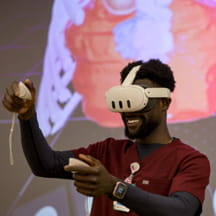In 2018, Texas Children's identified a problem when it came to patient access. So, the hospital focused on driving change, building an online scheduling and appointment process and most importantly, maintaining momentum.
Fast forward to 2020, and Texas Children's was well prepared for the unexpected. At the 2020 Annual Leadership Conference, Carrie Rys, assistant vice president, and Grace Karon, assistant director at Texas Children's, explained how this foundation of digital advancement allowed them to continue delivering care through the COVID-19 pandemic.
Expanding a digital footprint
Texas Children's needed to reimagine its digital capabilities. The hospital knew that to increase and expand these offerings, the organization would need to put a heavier focus on the patient and match what other industries were already doing with mobile platforms.
"This meant serving our patients and families, and referring providers, in the way they expect to receive our services," said Karon. "In the same way online takeout orders or grocery shopping is popular, it's clear our patients want to engage with their care that way as well."
With the help of MyChart, the hospital developed:
- Online scheduling
- Video visits
- Touch-free clinic experience and pre-check in
- Patient express lines
- Reminder messaging
Administrators met with each service line to explain how they wanted to structure telemedicine appointments. This led to some units with hybrid schedules, others primarily operating through telemedicine and others not at all.
An organization-wide effort
Texas Children's saw a 67% MyChart activation rate among patients. In comparison, the median activation rate for other MyChart users is 38%.
How did the hospital accomplish this? "It required really considering a cultural shift in how we thought about patient access," said Rys. "This was now becoming a culture around serving the patients and making it easier for them, and less about administrators or faculty ideas of access."To achieve high engagement and acceptance of MyChart and other programs, the entire hospital had to contribute to shift the culture. Whether it was a provider or scheduler, staff across the hospital consistently directed and informed patients to set up appointments and manage care through MyChart.
Accidental preparation
Without knowing it, the systems Texas Children's had put in place would be essential to care delivery amid the COVID-19 pandemic. "Facing COVID-19, our definition of access looked a little different," said Rys.
While Texas Children's adjusted and adapted along with the rest of the world, they kept the patient experience as a number one priority, according to Rys. However, now they had to shift to ensure continuity of care through telemedicine and foster a zero-touch environment.
With this pre-existing infrastructure, the hospital quickly pivoted to new protocols and best practices for patient care. By the end of July 2020, the hospital had expanded its program to 150,000 telemedicine appointments, 64 specialties, 1,450 providers and a total of 68,000 patients.


